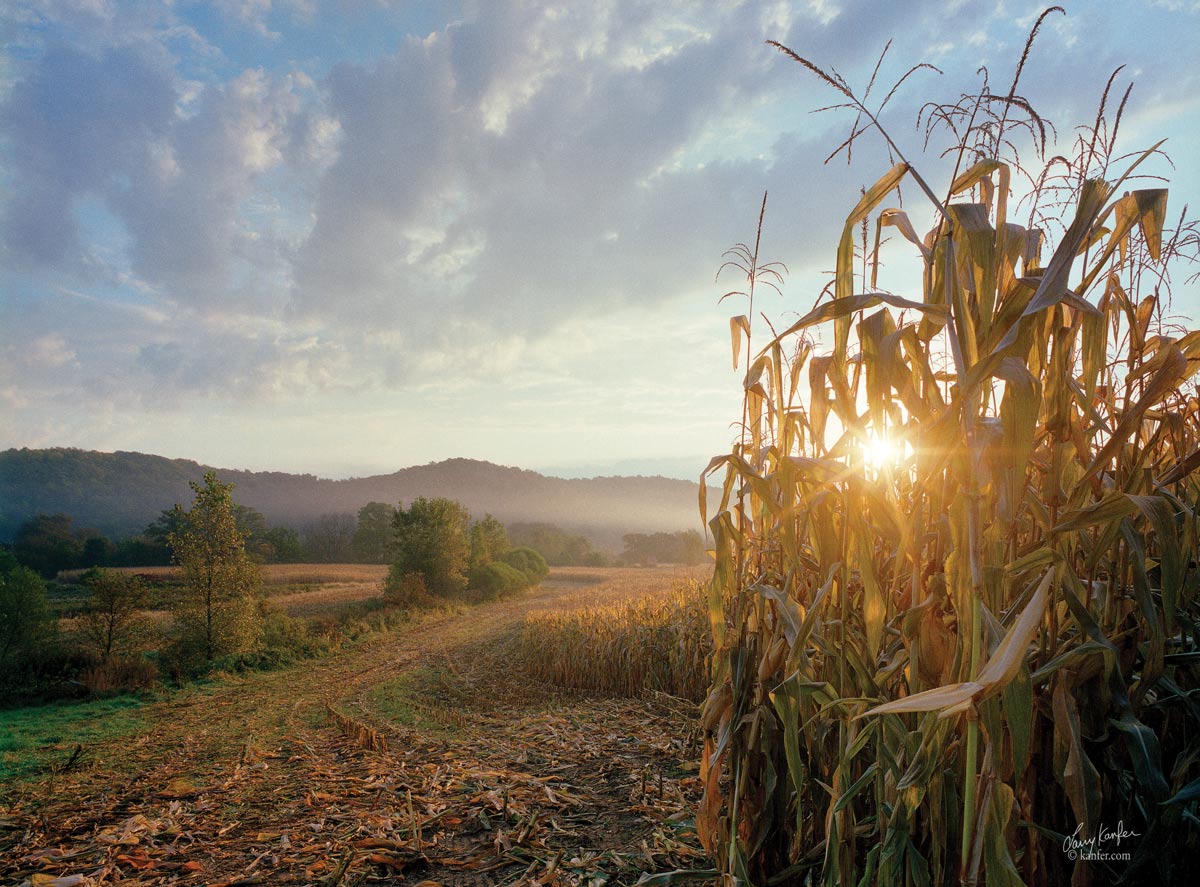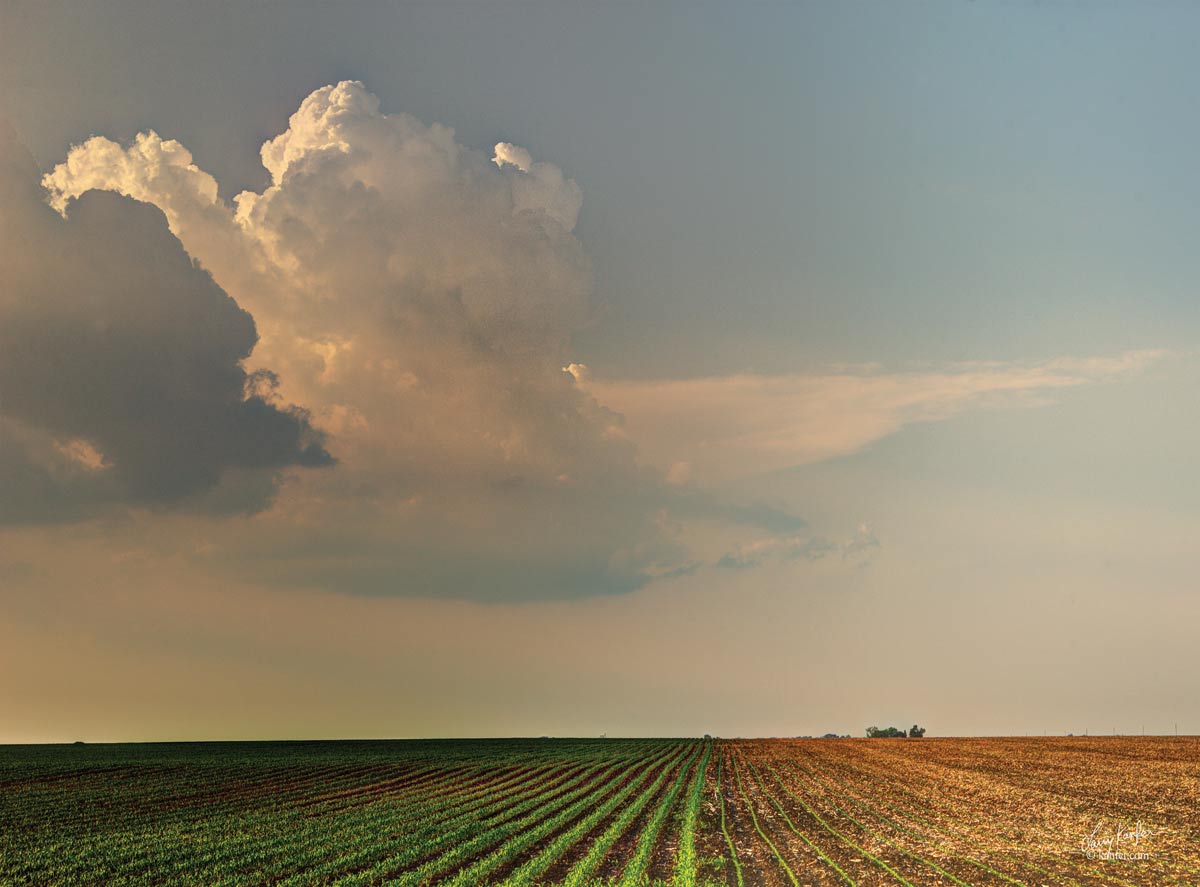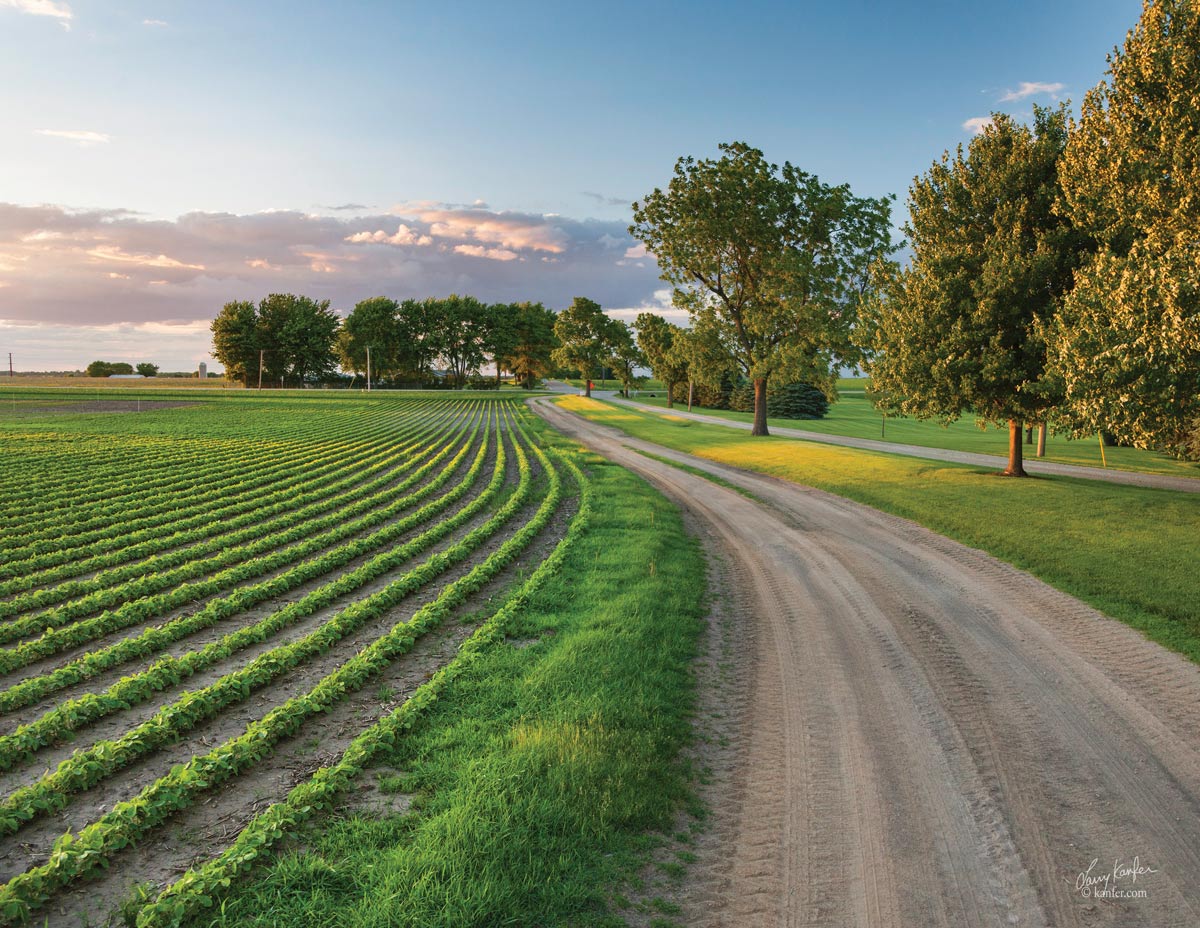
“It was early morning. The fog was just lifting, and the sun was coming out. Everything was golden.”
Photographer Larry Kanfer describes how his photograph “Full Circle” came to life. “Everything lined up. It was composition and time of day and a little bit my emotion. I took that photograph … and out in the middle of nowhere, you could probably hear me jumping up and down,” he laughs. “That was back in the film days, and I probably took three rolls of film just to make sure I had it.”
He seeks out moments of serendipity like these when everything lines up to create the perfect image, likening it to a sense of childlike discovery. “There’s that anticipation, but also the surprise,” says Kanfer. “There’s such a joy in that.” He believes people lose that as they grow older and the world becomes familiar. Reminding viewers of the wonder and excitement that accompanies these discoveries is just part of his passion for the work.
His personal experience in capturing these moments is another element. “Looking for serendipity with my camera, it makes me go out and see things. So many things you don’t see, you don’t know to look for them. You’re used to them, or you’re like ‘I see this every day I’m driving to work,’” he says. “A lot of times being an outsider looking in, you see things that insiders don’t see. Carrying a camera makes you a little bit of an outsider. It puts you on the other side of that fence.”

Technique is a vital part of capturing such serendipity in just two dimensions. For instance, how a viewer is drawn into the photograph. “Composition uses the rule of thirds, where there might be a road, going from the foreground, middle ground to the background,” says Kanfer. “You divide the picture by three, both vertically and horizontally. Those spots where [they] intersect … that’s a nice place to have a focus point. When the viewer looks at the photograph, there’s movement.”
He says it creates the illusion that the viewer is there, even though the image is only two-dimensional. “There’s one of my photographs called ‘Living on a Line,’” says Kanfer. “A little bit of farmland, and then just this tiny line where it all takes place.
“The more you look, the more you find,” he adds. “We have that in the Midwest.” Kanfer, who once lived in the northwest, explains that though it’s more subtle than the mountains or the ocean, the central part of the country conveys wonder through what he calls “the fullness of time.”
“We have that beauty chronologically,” he says. “In spring, after a cold winter, you get the storms. The air is warm. [The] breeze is getting more humid. You smell the farms. You get all these hints of what’s going to happen.”
Spring isn’t the only season that offers a sense of discovery in the Midwest. He describes winter months as a “white embossed landscape,” and explains that just one element in that environment can have a major impact. “It’s amazing to me the power that a two-dimensional image does have … just with one punch, like a punctuation point in the landscape.
“Then the furrows start showing up, the black soil, and you smell the richness,” he continues. “You start getting thunderstorms, and then they cultivate the land and the landscape changes from a deep rich black to a little bit of green. Before you know it, it’s the Fourth of July, and your landscape is like you’re in a maze, everything’s tall. Everything is still, and there’s an inflection point where it goes from hot to humid; the crickets are making all that summer noise. Then you get a bit of red and brown on the leaves, and almost in a flash, farmers rush to get their crops in.”
Newcomers to the region may not be aware of these temporal changes until they experience them firsthand. “After a while, you get to understand the beauty of the changes. It really is miraculous,” says Kanfer. “We get to live in a place where we can experience it so many different ways.”
He describes the seasons together as a whole as “landscape in the fullness of time.” “You look at the landscape, and it’s comfortable to know. This year is corn, next year is beans … it’s something you can rely on. There’s a solidness,” he says. “Like a tether to keep things from going off the rails.”
The fullness of time can also be used to describe the life of the now prolific Illinois photographer, whose artistic journey began as a child taking a photography class at a science museum in Oregon. “We did contact prints. So that was my first exposure to photography, so to speak,” shares Kanfer. “It was like magic. [The image] just appeared. I still have that print. … That magic is what I’ve always loved, being able to put emotions into two dimensions.”
Years later, he ran a small portrait business while earning his degree in architecture at the University of Illinois. When he graduated, he found himself at a crossroads. “I thought I’d give [photography] a year,” Kanfer laughs. “I like to say I’m still unemployed.”
The road wasn’t always easy. “There was high inflation. I went door to door and did family portraits. I kept wanting to put that money back into my equipment, [but] every week the price went up. It was touch and go for a while,” says Kanfer. Eventually, business began to build through word of mouth.

As a release, he would shoot landscapes. “I put one of them on the wall and someone loved it. They wanted to buy it. … I thought, ‘Hey, maybe I can do this,’” he says.
As it turned out, his background in architecture was beneficial in this new direction. Kanfer says conversations he had with one of his professors impacted his approach. “With architecture, you think about light and dark and planes, and juxtaposition of planes, shadows, etc. He helped me translate that and encouraged me,” he says.
Another important influence was Walter Creese, an architecture historian who later wrote the foreword to two of Kanfer’s books. “We had great conversations about the Midwest and about the landscape. That helped me to think about it in different ways,” he says.
Kanfer says what he learned as a student helped him embrace both sides of the brain, the emotional and the analytical. “I’ve done this my whole career. I’ll look at a photograph, and I’ll say, ‘What’s the composition, the exposure, how are the shadows, when are the shadows a certain way?’” he explains. “But then, in the design and architecture, there’s still the emotion. They taught me how to define the emotion … analytically.”
How a photo is developed also plays a crucial role in conveying the moment. Initially, Kanfer sent his photos out to be developed, but he began printing them himself after noticing some subtleties the lab overlooked. To this day, he uses Epson photo printers. “I have one that does canvas and photographic prints, and then I have one for dye sub and metal prints,” he says.
When shooting, Kanfer captures images as raw files with his Canon camera and later edits the files in Photoshop, sometimes using GigaPan technology to “stitch” together panoramic shots he previously created through a far more arduous process using large format cameras. And while he is amazed at the automation of today’s cameras, he says photographers who have only used digital and haven’t manually manipulated aspects like depth of field and exposure may not fully comprehend the reasons a photographer might choose to do so.
He likens the phenomenon to different music formats. “[You] could hear all the differences on a record. Then the MP3 came along and sort of compressed it. CDs were perfect, but they were a little flat. They didn’t have that fullness,” says Kanfer. “It takes a little bit more to really appreciate that extra.”
He names a couple of well-known photographers who have achieved that “extra” in their work. “I always loved the work of Harry Callahan. … He always had that serendipity in photographs, just very subtle,” he explains. “And Ansel Adams, just as high-quality black-and-white landscapes. I learned foreground, middle ground, background. He had all that interest in his work.”
Soon it would be Kanfer himself presenting his work in book form. In 1985, the editor of University of Illinois Press walked into his gallery in Champaign.
“It was one of those blizzard days; most everything was closed. He came in and said, ‘You know, we ought to do a book,’” recalls Kanfer. That book, “Prairiescapes,” proved to be a major stepping stone in the photographer’s career. Six more titles followed, among those “On Firm Ground” and “A Prairie State of Mind.” He is now in the process of putting together another book, this one focusing on places people gather.
“I think in our culture, people have become distant from each other,” he says. “I started thinking, let’s celebrate the places where people do get together. It’s a little different for me because there are a lot of people in it, obviously,” Kanfer adds. “[But] I did portraits and loved doing [them] for years.”
Like the title of his photograph, the artist and his work seem also to have come full circle. From the magic of that first contact print to a choice made at one of those integral crossroads in life, Kanfer’s serendipitous journey in the fullness of its own time has been measured in many moments and countless rolls of film, in its entirety proving that life sometimes truly does imitate art.









